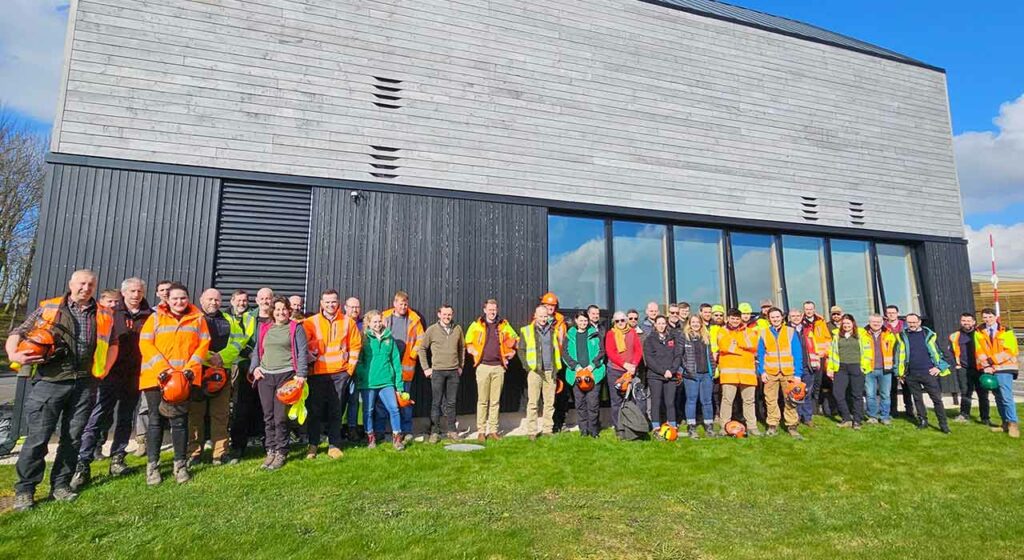Our Harvesting & Marketing Special Interest Group (SIG) held their first Study Tour in March 2024 in South Scotland. Emma Grey, Operations Manager at Scottish Forestry and member of the SIG, has reported back on the Study Tour’s activities and outcomes.
The first Harvesting & Marketing SIG tour began with an introduction from Neil McKay MICFor, Chair of the Institute’s South Scotland Regional Group. Over the next two days, forestry professionals from around the UK would visit various sites throughout Dumfriesshire to observe and discuss aspects of harvesting site planning and sawmilling.

Session one
The first visit was to Castlemilk & Corrie Estates led by the estate’s Woodlands Manager, Cat Kent. Cat is also a member of the Harvesting & Marketing SIG. The main objectives of the estate are commercial, public access and exploring agroforestry. Cat explained that Castlemilk has a lot of in-house resourcing to do most of the work within the estate however contractors are used to undertake larger machinery based harvesting work. The group were taken to a site heavily constrained with SPHNS, public-access, high pressure gas pipeline, overhead power-lines and a nature reserve. To date there were five SPHNs on the site, a lot of which were juvenile larch trees which provided some challenge in terms of operational method and marketing possibilities.
Cat explained there is a good mixture of soils throughout the estate therefore restocking will seek to diversify species with expansion of broadleaf habitats, and commercial species Norway spruce and Douglas fir. There are a number of hardwood areas in retention however due to the access issues with the SPHN, the priority will be the larch removal as per the deadline and some broadleaves will have to compromise. She also explained that a portion of the larch removal work is a cost job and the difficulties in balancing this with the deadline and other priorities.
The group discussed the best way to present a tender to allow buyers/contractors to bid for a job effectively. Clear and established information of the site should be presented from the offset to allow for understanding on pricing matrix, particularly when a site has a multitude of constraints to work within where the expectation of the seller should be outlined to support this. For sellers, this is difficult where then are a number of constraints at play and sometimes conflicting parameters on which to work within.
Public access is a key consideration for any work that goes on in the estate as people regularly use the forest roads and paths to take access. Castlemilk estate has taken the welcome approach of engaging with the local community early in the process to establish what they are going to do and how they are going to do it, and they have found this beneficial to all.
For utilities, previous SPHN work facilitated an arranged shut down. A further shutdown is being explored due to the risk of windblow falling onto the powerline. The utility company had a preference for a shutdown as opposed to live line working which can cause delays to operations.
In terms of the gas pipeline, road building may occur to facilitate this with potential use of bog mats. This is expected to cost the estate around £9k and there is no financial support available to undertake this work. The bog mats may be made in house with the band saws available to limit cost. They are also exploring with the company the constraints of working within a certain distance to the pipeline.
Session two
The group then moved on to the second site, Terra, part of the Eskdalemuir forestry portfolio led by George Birrel MICFor, Director of Kronospan. George explained the over-arching principles of business planning in relation to this area: 35 year portfolio plan (strategic document) leads 31 individual forest units (forest plan) from which an annual budget for operations is prepared. He explained the area is very good for growing commercial trees due to rolling hills, high rainfall, some gleyed soils on a bedrock of greywackes and shales, where the average tree size is approx. 0.6m3 per tree and the volume is about 600-650 m3 per hectare. There has been some windblow throughout the portfolio where 93 hectares were lost in Storm Arwen.
The group discussed constraints similar to last site, high public use, utility companies, private water supplies, archaeology and wildlife constraints that were often conflicting.
George said that species diversity is increasing gradually and they are trying to find species that yield the same as Sitka spruce. One of the main issues faced with restocking in this area is deer. Other considerations are the materials left over from harvesting such as brash, log bridges and rubbish (hydraulic hoses). George said that brash recovered sites appear to be much preferred by planters and provide a significantly cleaner site, also providing key advantages for wildlife management.
Session three
The last visit for day one was to the Langholm Hotel to view a presentation from the Langholm Initiative’s Angela Williams, who is their Development Manager. The subject of discussion was the community buy out and how the community have worked with harvesting to meet their objectives.
Tarras Valley nature reserve occurred after two community land buy-outs from Buccleuch Estate, totalling approximately 4,200 hectares. Over £6 million was raised by over 3,500 donors. The main objectives of the buyout are to connect the local community with the landscape whilst providing climate solutions and sustainable land practice through a community-led approach. The buyout also sets out to support regeneration throughout the Langholm area.
A main focus of the project is nature restoration of which includes removal of Sitka spruce and associated regeneration. They worked in conjunction with Tilhill to undertake a large potion of the harvesting work – this area was called the Tarras Strip plantation. Felling work occurred earlier than originally planned due to damage from Storm Arwen and it was deemed appropriate to clear before it degraded further. The site consisted of 36 hectares (approx. 15,000 tonnes) of SS/NS timber. The restocking aim is for natural regeneration of native species. There is a still an amount of Sitka spruce to remove throughout the land holding and this work will continue to occur as regeneration of spruce seedlings is prolific.
Throughout the process extensive community engagement was carried out. This included other stakeholders such as Scottish Power, Dumfries and Galloway and Scottish Forestry. The income from the timber supported investment back into community land. All timber went to the BSW Carlisle mill which is within 20 miles although other end users are involved (AW Jenkinson). A number of wildlife species were considered as part of the operation (badgers, red squirrels, pine martens, otters, goshawks). Volunteers will do some supplementary planting of native species if required.
As the presentation concluded there was a discussion on the place of commercial forestry in the wider landscape. It was evident the importance of community engagement and what this can entail for public perception on forestry practices.
Study Tour Dinner
In the evening, there was a presentation from David Leslie MICFor, Joint Managing Director at James Jones & Sons Ltd, on the development of harvesting, forwarding, haulage and sawmilling. The group listened to the origins of early commercial forestry and how the industry moved from manual saws to the highly sophisticated machinery we have today. Alongside increasing production, David touched on advancements in managing sawmills and harvesting sites to higher health, safety and environmental standards and what future may be in store with predicted yield volumes.
Session four
Following on from machinery development presentation the evening before, the next morning the group tried the John Deere simulator demonstration thanks to Lewis Bowsher.
The final stop on the study tour was to the James Jones & Sons sawmill in Lockerbie. The group listened to a presentation on the company’s development and innovation within the sawmilling industry both nationally and internationally. James Jones has a long family history with initial ventures in manufacturing and small scale sawmilling. Although aspects of the business has changed since the 1900s, the company has expanded throughout location and area of work. The latest ventures an opening on a new Durham site, many sites in Australia and various woodland creation schemes. In light of changes in species diversity in the UKFS, the group discussed what this may mean for current sawmilling practices. Developing buoyant markets and sawmilling techniques for non-white wood is a key consideration for foresters and sawmillers going forward.
After the presentation, Euan Borthwick MICFor, Assistant Harvesting Manager at James Jones & Sons and SIG member, and Rob McKenna, James Jones & Sons, led two groups on informative tours through the Lockerbie sawmill. These tours focussed on the scale of development and investment that James Jones have put into creating efficient sawmilling practices, ensuring to use all material possible from forest products.
The tour concluded with a short speech from the Institute’s Member Services Director, Dr Stuart Glen, who thanked the attendees and members of the SIG.






